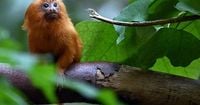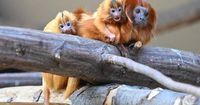The golden lion tamarin pair 'Apu' and 'Nala' at the Cologne Zoo has welcomed two new additions to their family. The tiny golden-yellow climbing artists were born on February 28, 2025, and have since been integrated into their group. The gender of the newborns is still undetermined, but both are reported to be healthy and thriving.
Located in the 'Arnulf-und-Elizabeth-Reichert-Haus,' which mimics the monkeys' natural habitat of tropical rainforests, the new arrivals are part of a growing family of golden lion tamarins at the zoo. This facility allows the animals to roam freely alongside other species, including white-faced sakis, armadillos, piranhas, toucans, and various birds. Additionally, visitors can catch glimpses of two sloths named 'Jumi' and 'Perez' in the same space.
With the birth of these two young tamarins, the total number of golden lion tamarins in the Cologne Zoo has reached six. The zoo management revealed that since the opening of the modern facility in 2022, a total of nine golden lion tamarins have been born, with some being transferred to other zoos.
In a delightful twist, Christoph Kiesow, a zookeeper at the South America House, shared, "We thought Nala could no longer have babies, so the pregnancy was a real surprise." The playful antics of the young tamarins, who sometimes steal food from the sloth's open mouth, have already charmed visitors.
Golden lion tamarins, known for their striking appearance resembling a lion's mane, are classified as clawed monkeys. They possess claws on their hands and feet, allowing them to scrape tree bark to access tree sap and insect larvae. Their diet primarily consists of fruits and tree saps, and they communicate using whistling sounds.
Once teetering on the brink of extinction in the early 1970s, when only about 200 to 600 individuals remained, golden lion tamarins are now making a comeback. They are native to a small region in southeastern Brazil, particularly in the state of Rio de Janeiro. To aid in their recovery, the 'Countdown 2025' project was launched in 1974, with zoos playing a critical role in their conservation through coordinated breeding programs.
The Cologne Zoo has actively participated in these efforts, donating 5,000 euros annually to the 'Save the Golden Lion Tamarin' project in Brazil since the opening of their facility. These funds support various initiatives, including:
- Connecting previously isolated forest patches through land purchases, allowing for the restoration of approximately 449 hectares of degraded pastureland back to original Atlantic rainforest between 1997 and 2024.
- Educational programs for the local population about the importance of forest protection and sustainable livelihoods that align with the rainforest and its inhabitants, such as ecotourism.
- Vaccination campaigns against yellow fever, a disease that poses a significant risk to lion tamarins, and regular population assessments.
A recent census in 2023 revealed a positive trend, indicating that the wild lion tamarin populations are recovering from yellow fever losses and are now inhabiting previously unoccupied forests. Experts estimate that the total number of golden lion tamarins in their area of responsibility has risen to over 2,000, with the potential for a total of 4,800 individuals.
For those looking to explore beyond the monkey habitat, the Cologne Zoo has also introduced a special exhibition called Dinoworld, which opened on April 12, 2025. Visitors can marvel at life-sized dinosaur figures, including Argentinosaurus, Triceratops, and Tyrannosaurus Rex, and enjoy a virtual reality experience that highlights the wonders of the prehistoric world.
As spring unfolds, the zoo's South America House has become a vibrant setting for families, where visitors can walk beneath and alongside the animals, observing them amidst lush tropical plants like palms, cocoa trees, and bromeliads. The playful nature of the golden lion tamarins, who are now over two months old, adds to the lively atmosphere.
In their native Brazil, golden lion tamarins were once on the brink of extinction, but conservation efforts have helped stabilize their populations. The Cologne Zoo's commitment to preserving this species reflects a broader dedication to wildlife conservation, ensuring that future generations can enjoy these remarkable creatures.
As the young tamarins continue to grow and thrive, the zoo staff plans to name them soon, with a focus on selecting names that reflect the region from which these animals originate. The excitement surrounding the new arrivals at the Cologne Zoo serves as a reminder of the importance of conservation and the joy that comes from nurturing wildlife.
For those interested in supporting conservation work, donations can be made through the Cologne Zoo’s website, contributing to ongoing efforts to protect and preserve the golden lion tamarin and its habitat.






